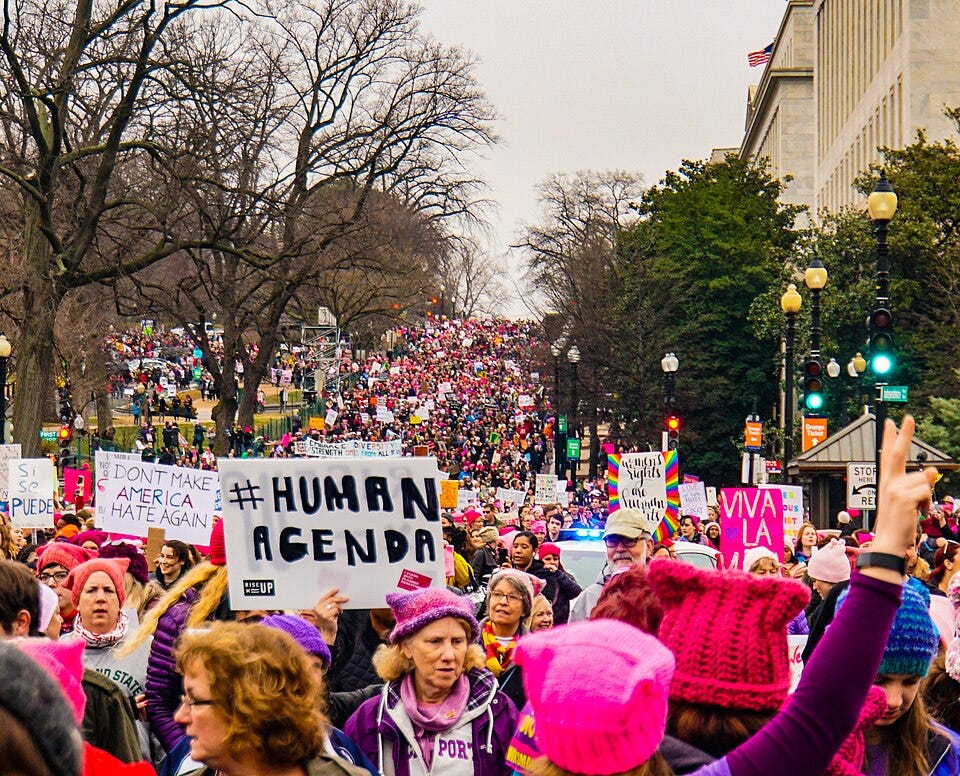“Hey, you.. Out there in the cold, getting lonely, getting old, can you feel me?”
Hey You, Pink Floyd
The story begins, as many do now, on Facebook. November 8, 2016. Teresa Shook, a retired attorney in Hawaii, sits at her laptop in a post-election stupor. Donald J. Trump has just been declared the 45th President of the United States. She clicks her way into “Pantsuit Nation,” a Clintonite refuge in the hellscape of post-Obama social media, and types a few angry, hopeful words: We have to march. She shares it with 40 friends. She sleeps.
By the time she wakes, 10,000 strangers have RSVP’d. Another 10,000 signal interest. America is still on fire, but now it has a meeting point.
The Women’s March would become the largest single-day protest in US history. On January 21, 2017, just a day after the inauguration, Washington, D.C., swelled with pink-hatted protestors, marching in defiance of a man whose idea of banter included grabbing women by the genitals. An estimated four million participants. Sister marches from Antarctica to Zimbabwe.
For a moment, the symbolism was irresistible: women — all women, it seemed — had arrived. They weren’t just protesting Trump; they were reclaiming the narrative. Here, finally, was the unity we were always promised but never delivered. Until it wasn’t.
Because if American politics is a dream machine, it also has a brutal wake-up alarm setting. And the splintering came not from the outside, not from the Right, but from within the movement itself.
It started with the name. Some organizers wanted to call it the “Million Woman March,” a reference meant to channel scale and history. But Black women called foul. The original Million Woman March was in 1997, in Philly, organized by and for Black women. A line was drawn. Vanessa Wruble, a white co-organizer, took the point and renamed it the Women’s March. She also tried to correct course by bringing in activists of color: Carmen Perez, Tamika Mallory, and later Linda Sarsour. Inclusion became the new organizing principle, not only racially, but ideologically, spiritually, aesthetically.
Which is where the hats come in. The pink pussy hat — part protest gear, part Instagram filter — was meant to reclaim the vulgarity of Trump’s now-notorious “locker room talk.” It was clever, tactile, memeable. A revolt in soft yarn. But for many trans women and gender non-conforming protestors, the symbolism was exclusionary, anatomical, and not a little smug. The pink assumed a standard, the pussy assumed a norm, and the norm was white. Marginalized groups called it out: this was TERF-adjacent feminism, they said, a protest wrapped in a color-coded identity politics that excluded the very people it claimed to champion.
Others piled on. Some saw the knitting itself as a class marker, a legacy of colonial leisure cloaked as solidarity. A hobby for some, a livelihood for others. A language of upper-middle-class white women, unfamiliar with the price of thread in other zip codes.
And then, the white women began to peel off. One wedding minister from South Carolina cancelled her trip to D.C. after scrolling through the posts. “Why is it now about, ‘White women don’t understand Black women’?” she asked, not unreasonably. On Facebook, survivors of assault found themselves being told to “check their privilege.” And you could almost hear the solidarity splintering in real time.
The divide deepened on reproductive rights — always the perennial fault line of American feminism. The Women’s March was proudly pro-choice, backed by Planned Parenthood, and explicit in its Unity Principles. But when it was discovered that two anti-choice organizations had been granted partner status, the backlash was immediate. The pro-choice camp held the line. Official statements were issued. Apologies, too. But the damage had been done. The pro-life contingent, some of whom considered themselves feminists, were shouted down, spat on, and had their signs torn apart.
One group yelled, “We still love you!” through the din. A strange moment of grace, or confusion, or both.
In retrospect, the Women’s March was never going to be a monolith. It was too big, too fast, too desperate to be pure. Its great success—its scale—was perhaps its fragility. Unity, as it turns out, is not a natural resource. It must be mined, refined, and constantly negotiated. And in the chaos of 2017, that negotiation never quite took place.
The movement began with a Facebook post and crescendoed into a march. But behind the signs and chants was a deeper, more combustible “culture war”-question: what does it mean to be a woman, and who gets to decide?







Identarianism has crept into every movement for social change. Former allies have now all gone to their corners. Just one more step towards authoritarianism. The oligarchs are thrilled.